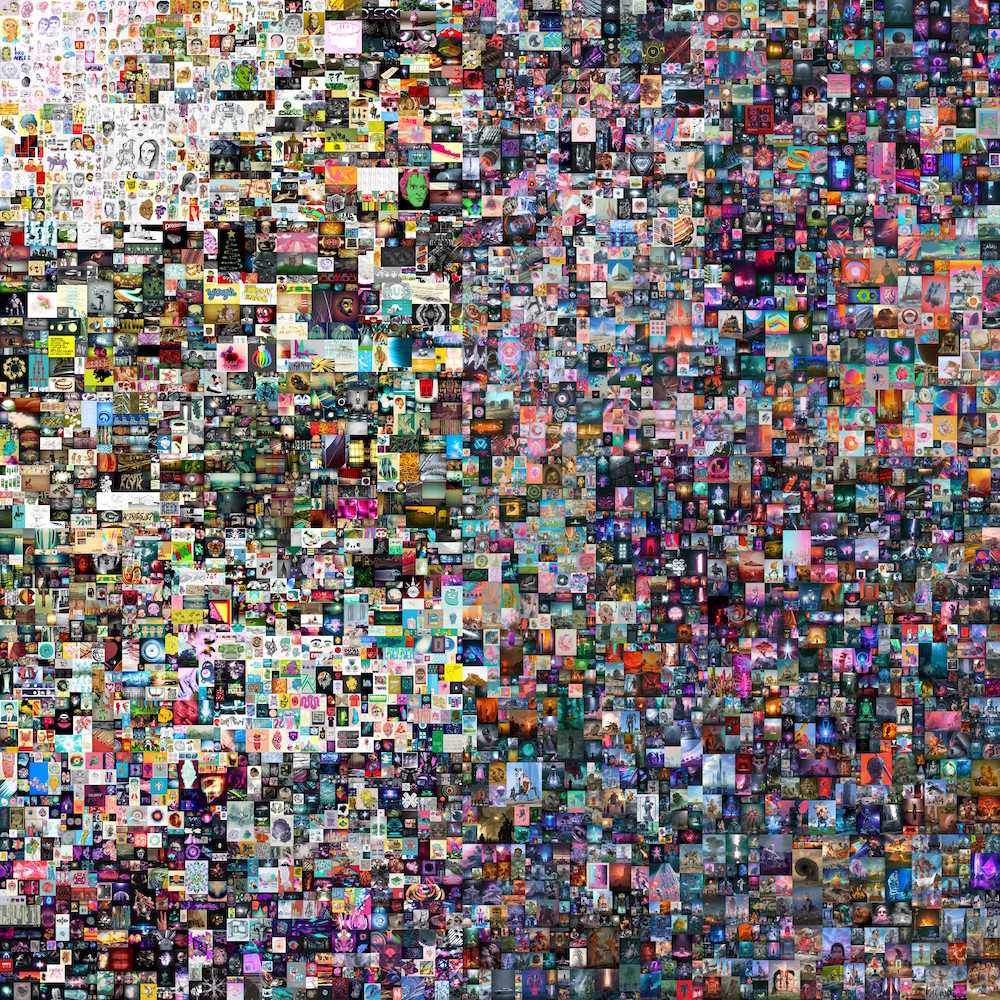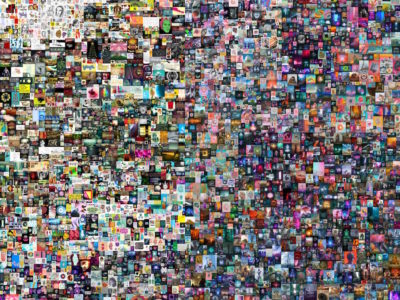The Metaverse of Non-Fungible Tokens
Beeple ( Mike Winkelman )1 sold a collage of jpegs for $69 Million and it is the the third most expensive artwork ever by a living artist. I say nice work Mike. I’m also a fan of Jeff Koons and David Hockney who hold the top two spots2,3. And although the talking heads do what they do, there seems to be a crowd of naysayers out there crying foul. I’m not in that camp, but the idea did get me to thinking about it this afternoon.
First off, you might be asking yourself what the hell is a non-fungible token4. You’ll need to understand what a blockchain5 is first. It’s as simple as this… a blockchain is just a digital ledger. It’s what powers cryptocurrencies by enabling them to authenticate every transaction. So a non-fungible token is just a unit on that ledger just like a cryptocurrency. What’s powerful about them is that it allows something that is easily reproducible in our copy/paste world like digital images to have an authenticated producer and owner. In that regard, it’s similar to copyright but the work can still be replicated and the creator can retain both copyright and the original.

What about the work deserved $69 million? It’s not exactly as scarce as an original Picasso or as rare as Fabergé egg. I have a degrees in studio art and art history and even trying to explain the art world at a family get together is still somewhat tricky. I like to explain along the lines of why LeBron James or Tom Hanks get paid so well. Those folks are just top of their game. The art world is very similar in that it’s just a little luck and a lot of skill. Mike Winkleman has it in a genre that is evermore coming to define the information age… digital artifacts and creations. The piece is entitled Everydays: the First 5000 Days6,7because it literally took him 5000 days to create. It’s 5000 individual digital artworks created with software. I can assure you that those can be just as time consuming as creating an oil painting. This espresso machine took me at least 10 hours and I’ve completed oil paintings in less. I looked through a good chunk of the individual pieces and the majority of them thoughtful, provocative, funny, timely, and well crafted.
There are tens of thousands of folks who do the whole essay, drawing, or whatever ‘a day’ sorta things and post them online. Beeple has a following though so fame is certainly a consideration, just like Tom Hanks. It’s true in every profession. You’ve gotta be respected and well liked or hated to come out on top. The record sales price certainly didn’t hurt his standings. You’ve also gotta be in tune with the collective consciousness and his work certainly touches a unifying nerve there. I remember when I had first gotten back into computers during college and an art professor mocking me for doing a stop frame animation of my work in progress. Poor fella is dead now, but I’d really enjoy showing him the thousands of videos of folks doing just that. I’ve never really craved the sort of attention that social media provides because I find it shallow. But it doesn’t mean that I don’t respect those who do and Beeple is on the money with it. Literally.
There’s also the consideration that the buyer made his money with cryptocurrencies and blockchain. The buyer even had has own digital identity Metakovan or Mumbai Metakovan. His real name is Vignesh Sundaresan8, now a Singapore based blockchain entrepreneur. He cofounded several bitcoin and cryptocurrency related businesses and explained his background in a post yesterday at https://metapurser.substack.com/p/nfts-the-first-5000-beeples 9. It’s a decent read about how a couple of coder kids from Tamil Nadu India made is big in cryptocurrencies. I’ve been to Tamil Nadu and again, I say good on them. And although some have speculated that it’s a promotional buy for his business, don’t you think that it’s comparable to when a broker has an original artwork in his apartment to impress. There’s an element to that in the art business. It’s the second largest unregulated market in the world right behind drugs and it’s full of the same sort of money laundering and crazy hijinks.
The word that really comes to mind about all of this is Metaverse10 and it’s what got me to thinking about it today. I remember when I was still idealistic about the internet or when I thought Second Life was destined to take over interactions. I set up a teleconferencing in our living room about eight years ago because I was convinced that everyone would just be making video ‘calls’ to each others living rooms. Dad still mentions to me that I told him that the internet, radio, and tv would be in the palm of you hand even though this was post iPhone version 1. Mom laughed when I said I was building internet widgets11 because she associated it with a slanderous term for someone hustling. Our parents pleaded us to stop wasting our time playing the original Zelda video game even though video gaming now outgrossing many other industries.
The word metaverse really encompasses what the art is all about. Much of the work involves rendering real objects into 3d worlds and the subject matter is often virtual in nature involving animated characters from film, pop culture and video games. The majority of the work has an ethereal otherworldly effect. You can see the actual progress in style based on the early series which started with drawings and photography and moved to Cinema 4D12 which is the software powering the majority of the creations and was built for 3d modeling. The software itself is based on ray tracing13 which is s technique for generating images by tracing light into pixels in an image plane simulating virtual objects. Ray tracing simulates the optical effects of lighting, was invented by the artist Albrecht Dürer14 in the 16th century, and tracks the development of computer hardware. So in a way, the art reflects the ability of computers to simulate reality. The combination of virtual worlds, augmented reality, and the internet is the metaverse in which the art exist. The existence as a non-fungible token on a blockchain just further exemplifies that metaverse as a perceived virtual universe.
I’ve come to be a bit more realistic about the timelines in which these things occur, but I still think that we are on the cusp on the information age. With it comes a whole Metaverse of collective virtual space be it in currency, art, video games or otherwise. Although the price tag is what made the headlines, the idea that virtual reproducible items have intrinsic worth is what is truly notable. I’m still building widgets to help connect us. After all, the term widget is just an abstract unit of production. And once we’re all truly connected in real time alongside all of the existing information, I’d be willing to speculate my own cryptocurrency that the very tangible dirt, air, food, and water will be where non-artificial scarcity occurs. I’ll likely be dead by then and some kid I knew can remember back when he was trying to tell me about the latest virtual metaverse.
- Mike Winkelmann – https://www.beeple-crap.com/everydays
- https://en.wikipedia.org/wiki/Rabbit_(Koons)
- https://en.wikipedia.org/wiki/Portrait_of_an_Artist_(Pool_with_Two_Figures)
- https://en.wikipedia.org/wiki/Non-fungible_token
- https://en.wikipedia.org/wiki/Blockchain
- https://en.wikipedia.org/wiki/Everydays:_the_First_5000_Days
- https://onlineonly.christies.com/s/first-open-beeple/beeple-b-1981-1/112924
- https://twitter.com/vigsun
- https://metapurser.substack.com/p/nfts-the-first-5000-beeples
- https://en.wikipedia.org/wiki/Metaverse
- https://en.wikipedia.org/wiki/Widget_(economics)
- https://en.wikipedia.org/wiki/Cinema_4D
- https://en.wikipedia.org/wiki/Ray_tracing_(graphics)
- https://en.wikipedia.org/wiki/Albrecht_D%C3%BCrer
